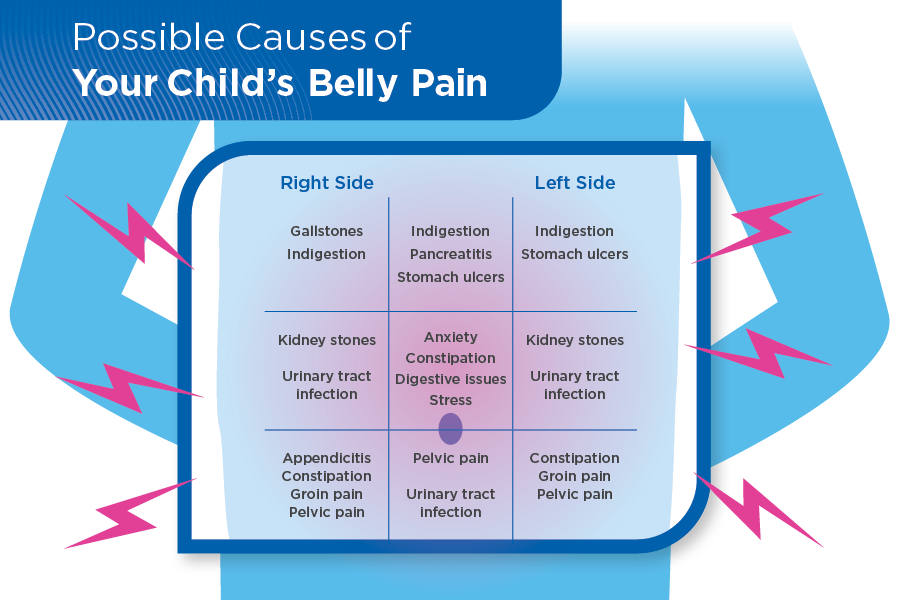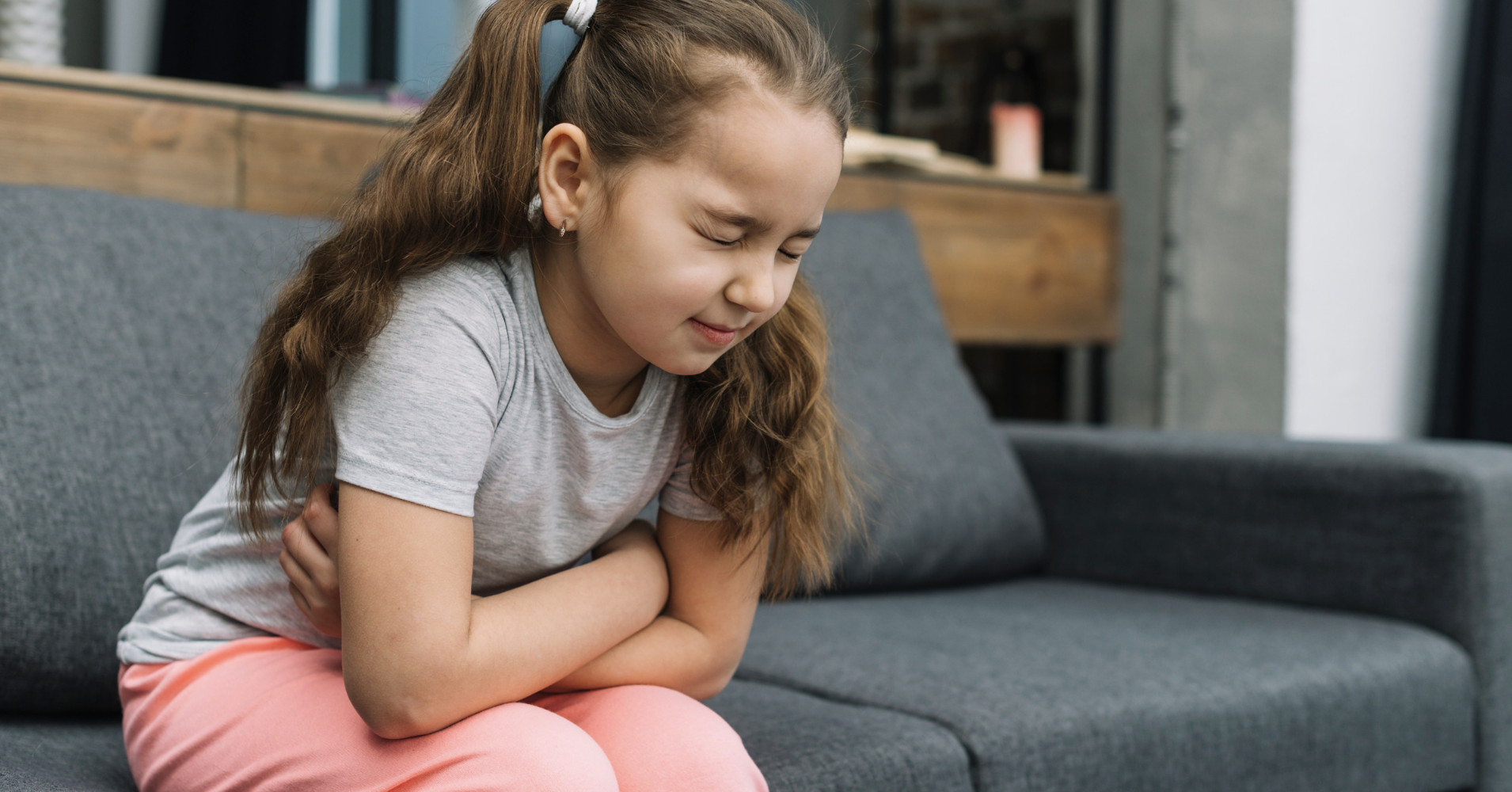There are numerous reasons an infant, child or adolescent experiences stomach pain, ranging from minor conditions that can be easily resolved at home to emergencies requiring urgent medical care. Parents often struggle to determine the cause of their child’s pain and whether it’s a minor illness or something more severe that requires medical attention.
Abdominal pain can be felt from the chest to the groin and everywhere in between. It can radiate, spreading to a larger area, and even appear under the ribs and in the back, making it difficult to determine the root cause.
The most common reasons children experience belly pain include:
- Functional abdominal pain (ongoing stomach pain that does not resolve with treatment)
- Indigestion or heartburn
- Stomach virus or bacterial infection
- Irritable bowel syndrome, including constipation or diarrhea
- Anxiety and stress (which does not imply your child’s symptoms are fake or “in their head”)
- Appendicitis

“Identifying the type, severity and location of abdominal pain your child is experiencing may help you determine the level of seriousness and required care,” said Jose Barrios, a pediatric gastroenterologist with Pediatrix® Gastroenterology of the Rocky Mountains. “Sometimes, gentle pressure in different areas can help parents find a sore spot. Make sure your hands are warm so your child doesn’t tense up.”
Infants and toddlers can’t explain their abdominal pain, so that’s a bit trickier. However, if they continually bring their knees toward their chest, are more fussy than usual or aren’t eating well, they are likely experiencing stomach pain. If this lasts more than a day, appears to worsen or your baby begins running a fever or isn’t making regular bowel movements, contact your baby’s pediatrician or visit an urgent care clinic or emergency room.
Abdominal Cramping
Stomach cramping often occurs suddenly and feels like a tight sensation in the stomach muscles. It can range from dull achiness to severe, stabbing-like pain. Abdominal cramping is generally not a sign of a serious medical condition. It is often caused by indigestion, bloating, constipation, gas, diarrhea, overeating, muscle strain or a stomach virus. With this type of pain, at-home remedies, over-the-counter medications, rest and lots of clear fluids will often resolve the issue.
Watch for signs of something more serious, such as:
- Pain that doesn’t improve within 24 hours
- Pain that recurs for a week or longer
- A fever above 100.4 degrees Fahrenheit
- Vomiting that lasts longer than 12 hours
- Bloating that lasts more than two days
- A burning sensation with urination
- Diarrhea lasting more than two days
- Tense abdomen (tight stomach)
Contact your child’s pediatrician if one or more of these signs accompany the pain.
Colicky Pain
Colicky pain occurs abruptly, is often severe and flares up in spasm-like waves. It is commonly associated with organs in the abdomen (gallbladder, rectum, small and large intestines) and urinary tract (bladder, kidneys, ureters, urethra).
This type of pain generally indicates a more serious condition, such as:
- Gallstones, kidney stones or urinary stones
- Bowel obstruction or blockages
- Crohn’s disease (an inflammatory intestinal disorder)
Colicky pain is typically sharp and localized in a specific area. It can come and go for weeks, months or even years.
“Consider a trip to the emergency room if your child appears to have colicky pain associated with fever or vomiting, has limited motion or the pain keeps him awake or wakes him from sleep,” said Dr. Barrios.
Infant Colic
Newborns may experience colic, which is vastly different from colicky abdominal pain seen in children, adolescents and adults.
In babies, colic may relate to a sensitivity or allergy to foods, eating too much or too little, infrequent burping or abnormal digestion. Most times, colic is a benign (harmless) process that gets better with age. It usually lasts until they are 3 to 4 months old. Common symptoms of colic include:
- Excessive, inconsolable crying for long periods
- Passing a lot of gas
- A distended or bloated belly
- Arching their backs and bringing their legs toward their chests when crying
Visit your baby’s pediatrician to determine if the symptoms are colic-related or due to another medical condition. The pediatrician can provide tips on how to soothe your colicky baby.
If your baby is not having bowel movements, is vomiting or has a fever, contact the pediatrician or visit an urgent care clinic or emergency room.
Generalized Abdominal Pain
Generalized pain is widespread, covering more than half of the belly. Like abdominal cramping, generalized pain doesn’t typically signify a serious condition. Issues such as indigestion, constipation, bloating, gas and stomach bugs can often cause stomachaches that span a larger area. Because the pain isn’t localized to a specific area, it may be more difficult to get to the root of the problem.
Usually, over-the-counter medications, such as antacids for indigestion or children’s laxatives for constipation, will help. Your child should avoid spicy foods and eat only bland foods (e.g., applesauce, toast, saltine crackers, bananas) for a couple of days. Also, make sure your child gets lots of rest and fluids.
Contact your child’s pediatrician if generalized pain continues for more than a few days. If the pain becomes severe, your child may have a more serious condition, such as an intestinal blockage, and should be taken to the emergency room.
Localized Pain
Contrary to generalized pain, localized pain is specific to only one area of the abdomen. It may be caused by mild, non-emergent conditions like bloating, gas, acid reflux or heartburn. However, it may indicate an issue that requires immediate medical care, such as problems with the appendix, gallbladder, pancreas, stomach, ovaries, testicles or a twisted bowel.
Following are possible causes of your child’s localized belly pain:
- Belly button (center of the belly) — Pain in this area is generally not serious and may be caused by constipation, digestive issues, anxiety or stress.
- Right upper — This could be as simple as heartburn or indigestion to something more severe with the gallbladder, such as gallstones.
- Right middle — Urinary tract infections and kidney stones are common causes of pain in this area; both require medical care.
- Right lower — This area can be a bit tricky because it may simply be constipation. It could also indicate pelvic or groin pain, potentially from a muscle strain, hernia or testicle or ovarian issue, among other conditions requiring medical care. It may be appendicitis, which requires immediate medical attention. Gynecologic conditions should be considered in adolescent girls as well.
- Upper middle — Pain in this area could be heartburn or indigestion but may also signify stomach ulcers or pancreatitis; both require medical care.
- Lower middle — Urinary tract infections may cause discomfort in this area. It could also indicate pelvic or groin issues.
- Left upper — As with the upper center and right, heartburn or indigestion may cause pain in this area. Stomach ulcers are also common with pain in the upper left side and require medical care.
- Left middle — Same as the right middle, pain in this area may point to a urinary tract infection or kidney stones, and you should contact your child’s pediatrician.
- Left lower — Constipation and pelvic or groin issues are common with pain in this area, as well as gynecologic problems.
“Most times when your child has a stomachache, there’s no need to worry,” said Dr. Barrios. “The more knowledge you have about common causes of stomachaches, the more likely you can distinguish between a minor issue and a severe condition requiring medical attention. If unsure, err on the side of caution and contact your child’s pediatrician or take your child to an urgent care clinic or emergency room.”
Visit our website to learn more about the Pediatrix network of medical providers, including pediatric gastroenterology and infectious disease specialists.
